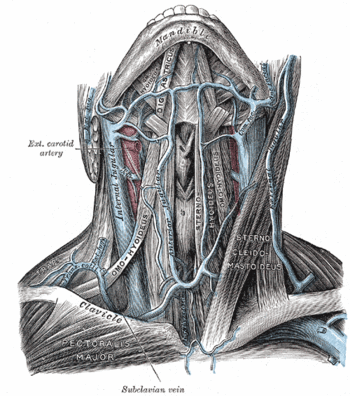Abdominojugular test: Difference between revisions
Pat Palmer (talk | contribs) mNo edit summary Tag: Reverted |
Pat Palmer (talk | contribs) mNo edit summary Tag: Reverted |
||
| Line 19: | Line 19: | ||
| [[Jugular venous distention]]|| 48%<ref name="pmid8594245"/>||88%<ref name="pmid8594245"/>|| 55% to 65%<ref name="pmid9169900"/>|| 74% to 80%<ref name="pmid9169900"/> | | [[Jugular venous distention]]|| 48%<ref name="pmid8594245"/>||88%<ref name="pmid8594245"/>|| 55% to 65%<ref name="pmid9169900"/>|| 74% to 80%<ref name="pmid9169900"/> | ||
|- | |- | ||
| Abdominojugular test||24% to 72%<ref name="pmid3415106" /><ref name="pmid2182296"/>||96% to 93<ref name="pmid3415106"/><ref name="pmid2182296"/>|| || | | Abdominojugular test||24% to 72%<ref name="pmid3415106" /><ref name="pmid2182296"/>||96% to 93<ref name="pmid3415106" /><ref name="pmid2182296"/>|| || | ||
|} | |} | ||
Revision as of 06:37, 4 May 2024
The abdominojugular test (AJR), also known as hepatojugular reflux, is used as an alternate test for measuring central venous pressure through the distension or swelling of the jugular vein. A positive AJR best correlates with the pulmonary capillary wedge pressure although it also correlates with the right heart pressure and the left heart ejection fraction [1].
Procedure
The examiner presses firmly over the center of the abdomen [1].</ref> for 10-60 seconds with a pressure of 20 to 35 mm Hg while observing the internal jugular vein in the neck and also observing to be sure the patient does not Valsalva [2]. The internal jugular vein can be distinguished from the carotid artery by 1) having a biphasic waveform 2) falling pressure during inspiration 3) rising with abdominal pressure, 4) increasing and decreasing with lowering and elevation of the head of the bed, respectively, and 5) being compressible with direct pressure [2].
- On an otherwise healthy individual, the jugular venous pressure remains constant or temporarily rises for a heartbeat or two, before returning to normal. This negative result would be indicated by a lack of swelling of the jugular vein.
- A positive result is variously defined as either a sustained rise in the JVP of at least 4 cm or more [2] or a fall of 4 cm or more [1].</ref> after the examiner releases pressure.
Interpretation
| Increased central venous pressure |
Increased left ventricular end diastolic pressure | |||
|---|---|---|---|---|
| Sensitivity | Specificity | Sensitivity | Specificity | |
| Jugular venous distention | 48%[2] | 88%[2] | 55% to 65%[3] | 74% to 80%[3] |
| Abdominojugular test | 24% to 72%[1][4] | 96% to 93[1][4] | ||
The AJR has a reported sensitivity of 24% [4] to 72% [1] and a specificity of 96% to 93%. The large discrepancy in sensitivity may be explained by the higher value being reported during performance in optimal conditions of a cardiac lab while the lower value was from a study in an emergency room.
References
- ↑ 1.0 1.1 1.2 1.3 1.4 1.5 1.6 Ewy G (1988). "The abdominojugular test: technique and hemodynamic correlates". Ann Intern Med 109 (6): 456-60. PMID 3415106.
Cite error: Invalid
<ref>tag; name "pmid3415106" defined multiple times with different content - ↑ 2.0 2.1 2.2 2.3 2.4 2.5 Cook DJ, Simel DL (1996). "The Rational Clinical Examination. Does this patient have abnormal central venous pressure?". JAMA 275 (8): 630-4. PMID 8594245.
Cite error: Invalid
<ref>tag; name "pmid8594245" defined multiple times with different content Cite error: Invalid<ref>tag; name "pmid8594245" defined multiple times with different content Cite error: Invalid<ref>tag; name "pmid8594245" defined multiple times with different content - ↑ 3.0 3.1 3.2 Review: Subtle clinical findings can detect left-sided heart failure in adults. ACP J Club. 1998 Jan-Feb;128(1):11. Review of PMID 9169900
- ↑ 4.0 4.1 4.2 4.3 Marantz P, Kaplan M, Alderman M (1990). "Clinical diagnosis of congestive heart failure in patients with acute dyspnea". Chest 97 (4): 776-81. PMID 2182296.
Cite error: Invalid
<ref>tag; name "pmid2182296" defined multiple times with different content
